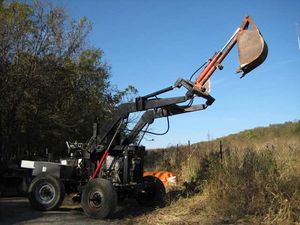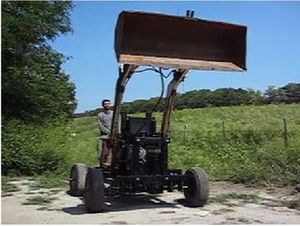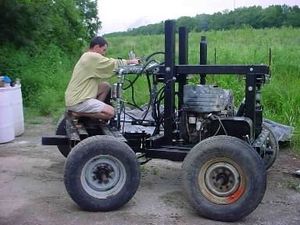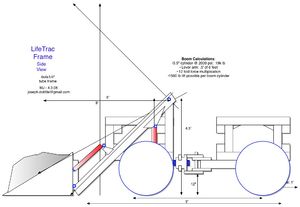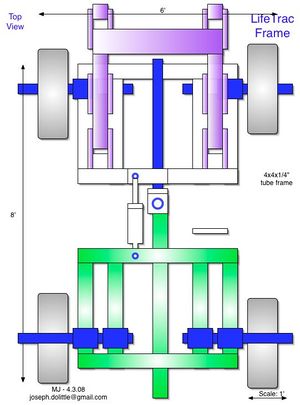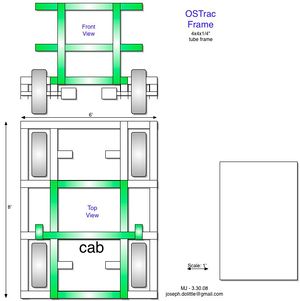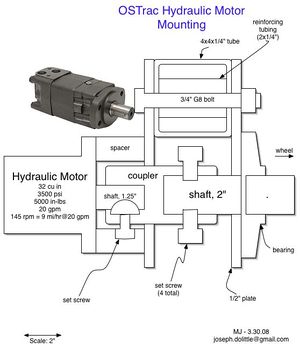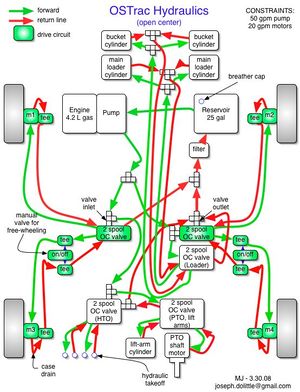LifeTrac I
Lifetrac / LifeTrac I
Overview
This is the first prototype of the LifeTrac - competed in September, 2008. See LifeTrac I Blog Post. It was OSE's first attempt to make a riding tractor using articulated steering.
This page tries to capture the work done on the LifeTrac I for easy reference. Please go to the LifeTrac page for the latest version of the LifeTrac with more complete instructions.
Research and Development
LifeTrac Frame
Initial Conceptual Drawings
OSTrac Frame
OSTrac Wheel Mounting
- Note: this shaft mounting diagram is incorrect. A second bearing needs to be used next to the motor so shaft is fully supported on bearings, not on motor shaft.
OSTrac Hydraulic System
Lessons Learned
(Copied from here) We have already built LifeTrac, the world's first, high performance, open source, multipurpose tractor. Our learnings from this project are:
- Design-for-disassembly via bolt-together xyz beam design is feasible for building heavy equipment
- Initial results indicate that complete, life-size Erector Set or Lego Set for real technology can be built using stock steel and components
- Lifetime design, modularity, simplicity, and ease of maintenance are key features
- Initial results indicate that DIY kits - reconfiguarable from small tractors to bulldozers just like Lego Blocks - with interchangeable motors and power units - are a viable route to widespread adoption of the technology
- Cost performance in the DIY scenario appears to be a factor of 10 improvement over the competition
- Machine combines functionality of an agricultural tractor and a skid loader
- Material costs for LifeTrac I were $4k ($500 engine, $2000 hydraulics, $1000 frame,$500 balance of system including used 16" wheels for $5 each)
Performance Review
To date, LifeTrac I has undergone over 4 years of field testing. Bucket work, CEB press power, backhoeing, power generator work, bale spiking, tree hole augering, disking, rototilling, soil pulverizing, and other uses were performed. During initial testing, the articulated joint cracked in half and was redesigned completely. Since then, there have been no mechanical problems, such that down time never lasted more than a few minutes due to ready ability to repair.
While long-term performance only will determine whether LifeTrac is worthy of its implied lifetime-design name - the results after 1 year of operation are promising. No visible leaks are to be found on any of the hydraulic motors and cylinders.
Observations
- Hydraulic drive via a diesel engine reduces the mechanical complexity by eliminating the transmission-clutch-differential-drive train-steering-braking, and replacing it with hydraulic flow, valves, and hydraulic actuators that perform all of the above functions
- Thus, power transmission components are decoupled and made modular
- Hydraulic system is robust and flexible. It allows devices on and off the tractor to be powered using 3 sets of 12 gpm outlets.
- Articulated steering is an effective means of performing short-radius turns
- Articulated joint both rotates and moves side-to-side, keeping 4 wheels on the ground under all conditions
- Pressure can be varied everywhere with adjustable pressure reliefs
- Custom implements, such as soil pulverizer, and many others can be used with LifeTrac
- PowerCube can mount on the quick attach of LifeTrac I for auxiliary power in case of engine failure
Improvements Needed
- In muddy conditions, the wheels spin out completely, so machines post LifeTrac VI have optional tracks as a possible module.
- Roll-over protection should be added.
- Power Cube module should be added instead of using a dedicated engine.
- 3 point hitch module should be added.
2015 Review
- As of Sep. 2012, the turbo pump on the built-in diesel engine sprung a leak, and is an estimated $1000 fix. We can avoid this by simply putting a Power Cube on the back of this tractor. LifeTrac I did not have a separate Power Cube - but a built-in engine. Since then, our modular design evolved to Power Cubes as modular power units. In 2014, a student inadvertantly destroyed the hydraulic system. As of 2016, Refurbishing the tractor with a Power Cube, as well as refurbishing the hydraulics - is being considered for showcasing this tractor as a historic artefact of Factor e Farm.
Additional Links
- Blog - Blog about being in Make Magazine
